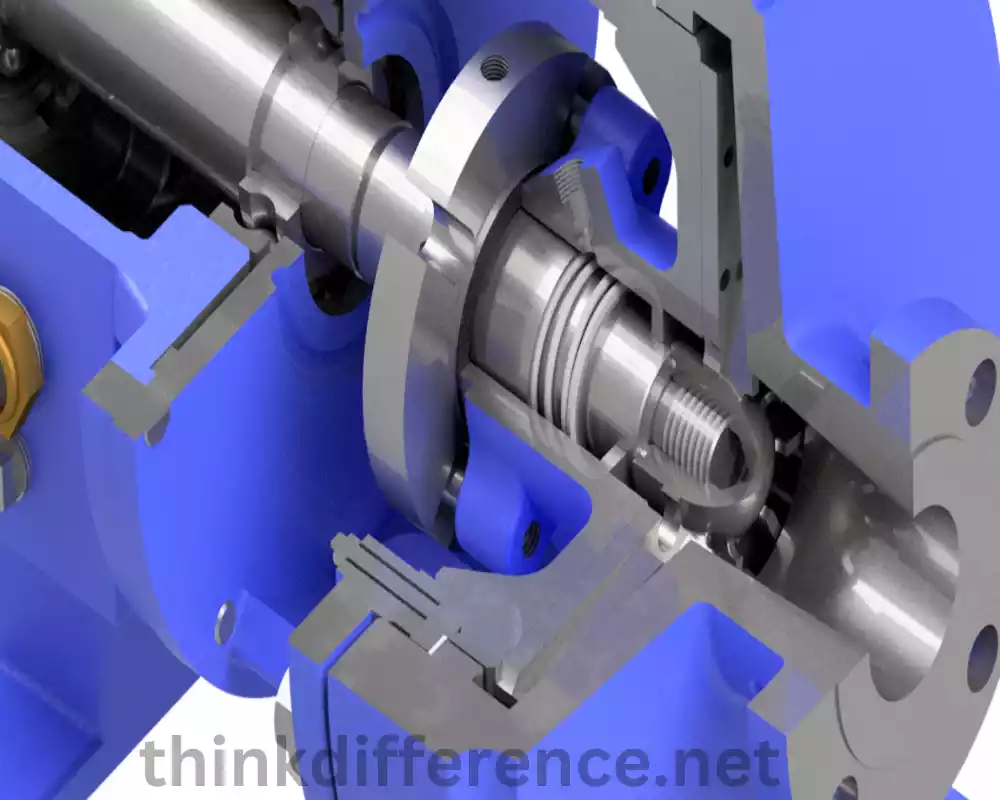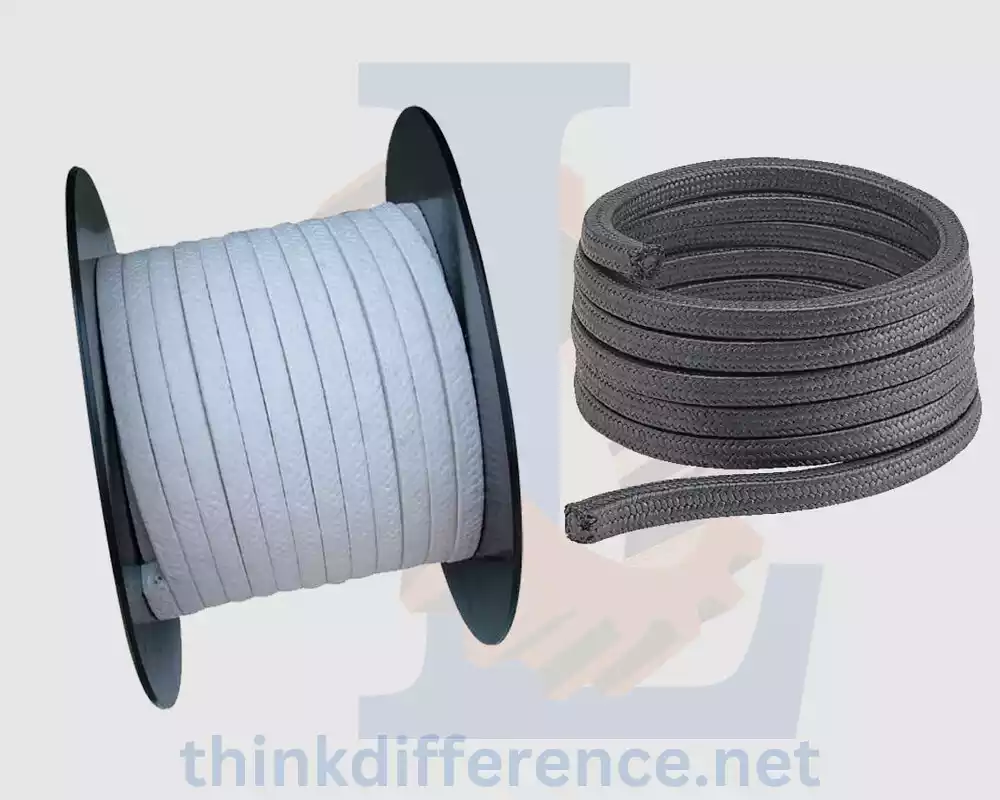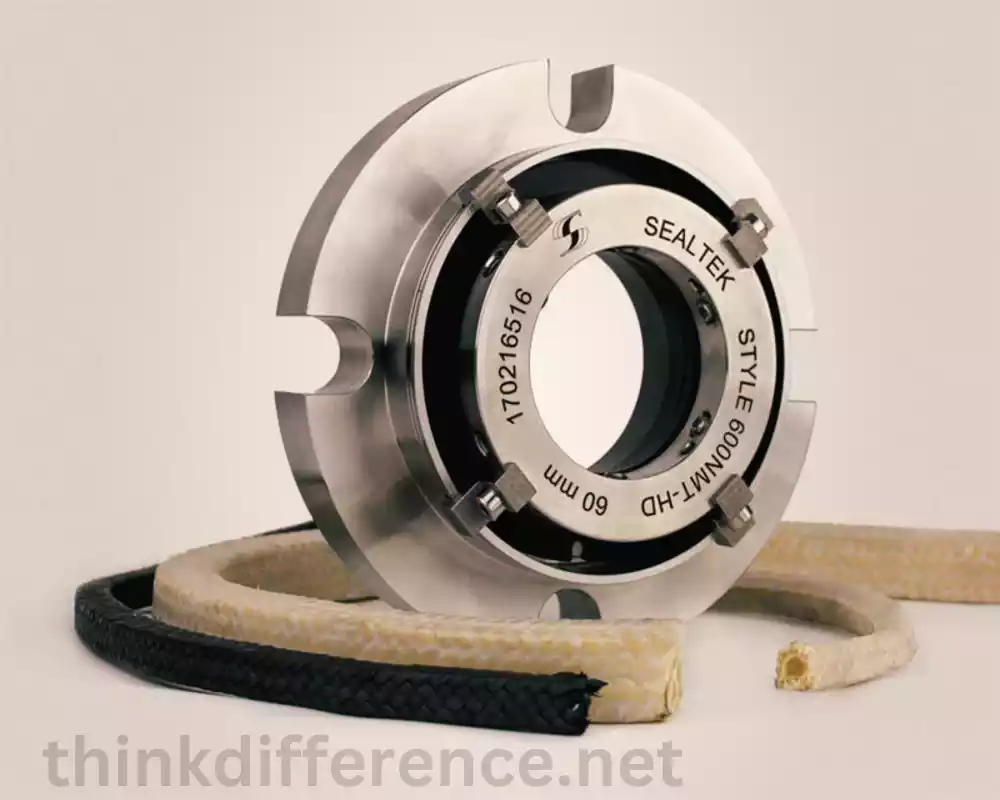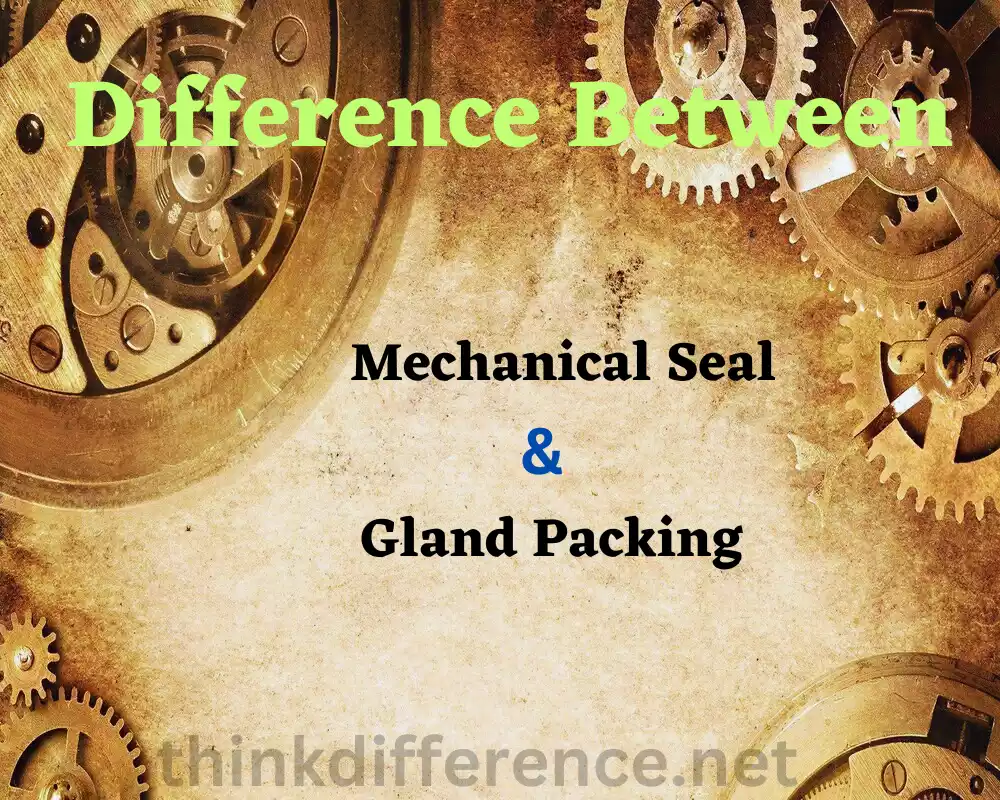Gland packing and mechanical seals are two popular choices when it comes to sealing solutions, with gland packing being one popular method and mechanical seals another popular option. Being aware of these two techniques’ differences will enable professionals to make informed choices when selecting an optimal sealing method for their unique sealing requirements.
Definition of Mechanical Seal and Gland Packing
Mechanical seal:
A mechanical seal is a device used to provide a dynamic seal between two rotating or reciprocating components in machinery, typically used in pumps, compressors, and other fluid-handling equipment. Composed of numerous elements that include rotating components connected to a shaft and stationary elements inside their housing as well as gaskets or O-rings to seal them, this device offers precision in operation.
The primary function of a mechanical seal is to prevent leakage of fluid, such as liquid or gas, along the rotating shaft and into the surrounding environment. By creating a tight seal between the rotating and stationary components, mechanical seals help maintain the integrity and efficiency of the equipment while minimizing fluid loss or contamination.
Gland Packing:
Gland packing, also known as mechanical packing or simply packing, is a sealing method used in machinery to prevent leakage of fluid, typically in applications where a mechanical seal may not be suitable or preferred. It involves the use of a compressible material, such as braided or molded fibers, which is inserted into the space between the shaft and the housing of a rotating or reciprocating component. The packing material is tightly packed into a gland or stuffing box, which is a chamber that surrounds the shaft.
As the packing material is compressed, it forms a seal that restricts the flow of fluid along the shaft and minimizes leakage. Gland packing requires periodic adjustment or tightening to maintain an effective seal, and the compression is often achieved by using a compression ring or follower.
It is commonly used in applications where there are lower pressures, slower speeds, or when the equipment operates with abrasive or corrosive fluids. Gland packing has been a traditional sealing method and is still utilized in various industries today.
What is Mechanical Seal?
A mechanical seal is a device used to provide a secure and effective sealing between two mechanical components, typically a rotating shaft and a stationary housing or casing. It is commonly employed in pumps, compressors, mixers, and other types of machinery where the prevention of fluid leakage is crucial.

Mechanical seals serve a vital function, impeding fluid out of systems by acting as obstructions to their flow – particularly gases and liquids such as gases or liquids that leak out. By maintaining a tight seal between the rotating and stationary parts, mechanical seals ensure the integrity of the equipment and protect it from potential damage caused by leaks.
Mechanical seals consist of several key components, including:
- Stationary Seal Face: This face remains fixed and is typically attached to the equipment housing. It is made of a hard and durable material like ceramic or carbon.
- Rotating Seal Face: This face is connected to the rotating shaft and moves with it. It is typically made of a softer material like carbon or a synthetic elastomer.
- Secondary Sealing Elements: These elements, such as O-rings or gaskets, provide additional sealing and prevent fluid leakage along the shaft or between the seal faces.
- Spring or Bellows: A spring or bellows mechanism applies a constant force between the seal faces, ensuring proper contact and sealing even in the presence of shaft movement or misalignment.
The working principle of a mechanical seal involves the close contact and sliding action between the rotating and stationary seal faces. This sliding action, along with the applied pressure from the fluid being sealed, creates a tight seal that prevents leakage.
Mechanical seals offer several advantages over alternative sealing methods, such as gland packing. They provide higher sealing efficiency, lower leakage rates, and are more suitable for high-pressure and high-speed applications. They also offer improved reliability, reduced maintenance requirements, and longer service life.
Mechanical seals play a vital role in maintaining the integrity and efficiency of various industrial systems by effectively sealing rotating shafts and preventing fluid leaks.
What is Gland Packing?
Gland packing, also known as mechanical packing or simply packing, is a traditional method used for sealing rotating or reciprocating shafts in machinery. It provides a reliable means of preventing fluid leakage in applications where a mechanical seal may not be suitable or preferred.

Gland packing involves the use of a compressible and resilient material, typically made of braided or molded fibers, such as graphite, PTFE (polytetrafluoroethylene), aramid, or synthetic yarns. This material is cut into rings or strips and inserted into the space between the shaft and the housing, forming a seal. The packing material is packed tightly into a chamber called the gland or stuffing box, which surrounds the shaft.
The primary working principle of gland packing is based on the compression of the packing material against the shaft, creating a seal that restricts the flow of fluid along the shaft and minimizes leakage. The packing material conforms to the irregularities of the shaft surface and fills the space between the shaft and the housing, effectively sealing the gap.
To maintain an effective seal, gland packing requires periodic adjustment or tightening. This is typically achieved by using a compression ring or follower that applies pressure to the packing material, compressing it further against the shaft. The compression can be adjusted to control the leakage rate while maintaining an acceptable level of friction and wear.
Gland packing has certain advantages that make it suitable for specific applications. These include:
- Lower Cost: Gland packing is generally less expensive compared to mechanical seals, making it a cost-effective sealing solution, particularly for smaller and less critical applications.
- Tolerance for Misalignment and Vibrations: Gland packing can accommodate shaft misalignment, axial movement, and vibrations better than mechanical seals. This makes it suitable for equipment that experiences these operational conditions.
- Resistance to Abrasive and Corrosive Fluids: Gland packing can handle abrasive or corrosive fluids more effectively than certain mechanical seal materials, providing a robust sealing solution in such environments.
Gland packing also has some limitations and disadvantages:
- Higher Maintenance Requirements: Gland packing requires periodic adjustment and replacement to maintain its sealing effectiveness. This can result in more frequent maintenance compared to mechanical seals.
- Increased Risk of Leakage: Due to the nature of the packing material, there is a higher possibility of slight leakage compared to mechanical seals, especially under high-pressure or high-speed conditions.
- Limited Suitability for Certain Applications: Gland packing is not well-suited for applications with extremely high pressures, high speeds, or stringent environmental requirements. Mechanical seals may be a more appropriate choice.
Gland packing is a traditional sealing method that offers advantages such as lower cost, tolerance for misalignment and vibrations, and resistance to abrasive and corrosive fluids. It requires regular maintenance and may have limitations in certain demanding applications.
Comparison between Mechanical Seal and Gland Packing
When comparing mechanical seals and gland packing, there are several factors to consider.
Here is a comparison between the two sealing methods:
- Sealing Efficiency:
- Mechanical Seal: Mechanical seals generally offer higher sealing efficiency compared to gland packing. They provide a more reliable and robust seal, minimizing fluid leakage and reducing the risk of equipment damage or contamination.
- Gland Packing: Gland packing, although effective, may have a higher likelihood of slight leakage compared to mechanical seals. It requires periodic adjustment and maintenance to maintain an acceptable level of sealing efficiency.
- Cost Considerations:
- Mechanical Seal: Mechanical seals typically have a higher initial cost compared to gland packing. They often provide long-term cost savings due to their improved sealing efficiency, reduced maintenance requirements, and extended equipment lifespan.
- Gland Packing: Gland packing is generally less expensive upfront, making it a cost-effective option for smaller or budget-sensitive applications. It may require more frequent maintenance and replacement, resulting in higher long-term costs.
- Application Suitability:
- Mechanical Seal: Mechanical seals are well-suited for a wide range of applications, including high-pressure and high-speed environments. They can handle demanding conditions and provide reliable sealing performance.
- Gland Packing: Gland packing is suitable for applications with lower pressures, slower speeds, or where shaft misalignment and vibrations are present. It may be preferred for certain abrasive or corrosive fluid-handling operations.
- Maintenance and Replacement:
- Mechanical Seal: Mechanical seals generally require less frequent maintenance and replacement compared to gland packing. They are designed for long-term use, and replacement intervals are typically longer.
- Gland Packing: Gland packing requires periodic adjustment, tightening, and eventual replacement due to wear. It demands more regular maintenance and attention to ensure proper sealing performance.
Mechanical seals offer higher sealing efficiency, better long-term cost-effectiveness, and broader application suitability. They are suitable for high-performance applications and require less frequent maintenance. Gland packing has a lower initial cost, tolerates misalignment and vibrations, and can handle certain abrasive or corrosive fluids.
It may require more frequent maintenance and has a higher likelihood of slight leakage. The choice between mechanical seals and gland packing depends on specific application requirements, operating conditions, and budget constraints.
Importance of sealing systems in various industries
Sealing systems play a crucial role in various industries by ensuring the integrity, safety, and efficiency of equipment and processes.
Here are some key reasons highlighting the importance of sealing systems:
- Leakage Prevention: Sealing systems are primarily designed to prevent leakage of fluids, gases, or contaminants. Whether it’s preventing leakage of hazardous chemicals in chemical plants, oil leakage in refineries, or water leakage in water treatment facilities, effective sealing systems are vital to maintaining a safe and controlled operating environment.
- Equipment Reliability and Efficiency: Sealing systems contribute to the reliability and efficiency of equipment by minimizing fluid losses, reducing energy consumption, and improving overall system performance. Properly sealed equipment operates more efficiently, leading to cost savings, reduced downtime, and increased productivity.
- Environmental Protection: Sealing systems help prevent the release of hazardous or polluting substances into the environment. Environmental regulations dictate the necessity of durable sealing systems across industries like petroleum or gas production, petroleum petrochemical manufacturing and wastewater treatment plants to comply with environmental legislation while mitigating any negative environmental impacts on ecosystems.
- Safety and Personnel Protection: Sealing systems play a significant role in protecting workers and equipment within an assembly. Seals that work effectively stop harmful substances leaking out, decreasing injuries as well as exposure to toxic materials or health risks for operators or workers working within machinery or systems.
- Product Quality and Contamination Control: Sealing systems play a vital role in food, drink, pharmaceutical, semiconductor and food manufacturing industries to maintain product quality while preventing contamination of product batches. By preventing the ingress of foreign particles, microbes, or contaminants, sealing systems help ensure the integrity and purity of products.
- Equipment Longevity and Maintenance: Sealing systems contribute to the longevity of equipment by protecting critical components from wear, corrosion, and damage. Properly sealed equipment experiences reduced mechanical stress and extended service life, reducing the need for frequent repairs or replacement.
- Energy Conservation: Effective sealing systems contribute to energy conservation by minimizing leakage and optimizing equipment performance. By preventing energy losses associated with fluid leakage or inefficient operation, sealing systems help industries achieve their energy-saving and sustainability goals.
- Process Efficiency and Optimization: Sealing systems enable precise control and optimization of processes by ensuring accurate pressure, flow, and temperature management. Proper sealing solutions help maintain process parameters within specified ranges, enhancing process efficiency, product quality, and operational performance.
Sealing systems are of paramount importance in various industries. They provide leakage prevention, contribute to equipment reliability and efficiency, protect the environment, ensure safety, maintain product quality, prolong equipment life, conserve energy, and optimize processes. Industries rely on effective sealing systems to achieve operational excellence, regulatory compliance, and sustainable practices.
Applications of Mechanical Seals and Gland Packing
Mechanical seals and gland packing have distinct applications based on the specific requirements and operating conditions of different industries.
Here are some common applications for both sealing methods:
Applications of Mechanical Seals:
- Pumps: Mechanical seals are extensively used in centrifugal pumps, including water pumps, process pumps, and chemical pumps. They provide reliable sealing solutions for a wide range of fluids, pressures, and temperatures encountered in pumping applications.
- Compressors: Mechanical seals are commonly used in various types of compressors, such as reciprocating compressors and centrifugal compressors. They help prevent gas leakage and maintain system efficiency in high-pressure environments.
- Mixers and Agitators: Mechanical seals are employed in mixers and agitators used in industries such as pharmaceuticals, chemicals, and food processing. They ensure a leak-free operation while withstanding the mechanical stresses and movements associated with mixing and agitation processes.
- Automotive Industry: Mechanical seals find applications in automotive engines and drivetrain systems. They are used in water pumps, fuel pumps, and other critical components to prevent fluid leakage and maintain optimal performance.
- HVAC Systems: Mechanical seals are utilized in heating, ventilation, and air conditioning (HVAC) systems, particularly in pumps and compressors. They help maintain the efficiency and reliability of HVAC equipment, reducing energy consumption and ensuring proper temperature control.
Applications of Gland Packing:
- Valves: Gland packing is commonly employed in various types of valves, including gate valves, globe valves, and control valves. It provides effective sealing for valve stems, preventing leakage in both high and low-pressure applications.
- Agitators and Mixers: Gland packing is used in agitators and mixers that handle corrosive or abrasive fluids. Its flexibility and tolerance for shaft movement make it suitable for applications with shaft misalignment and vibration.
- Slow-Speed Equipment: Gland packing is often preferred for slower rotating equipment, such as reciprocating pumps, slow-speed mixers, and some older machinery. Its ability to adapt to irregularities in the shaft surface and accommodate movement makes it suitable for such applications.
- Marine Industry: Gland packing is employed in various marine applications, including ship propulsion systems, stern tube seals, and other rotating equipment on vessels. It offers durability and reliability in harsh marine environments.
- Mining and Power Generation: Gland packing is utilized in equipment found in mining operations and power plants, including slurry pumps, coal handling systems, and cooling water pumps. It provides effective sealing against abrasive materials and withstands demanding operating conditions.
It’s important to note that while mechanical seals have gained popularity in many applications due to their higher sealing efficiency, gland packing continues to be used in specific industries and equipment where it offers advantages such as tolerance for shaft movement, cost-effectiveness, and resistance to certain harsh conditions.
The choice between mechanical seals and gland packing depends on factors such as the application requirements, operating conditions, and industry standards.
Choosing Between Mechanical Seals and Gland Packing
When making the choice between gland packings or seals made of mechanical material for meeting specific needs, several considerations must be kept in mind.

Here are the most essential ones:
- Sealing Efficiency: Evaluate the required level of sealing efficiency for your application. Mechanical seals generally offer higher sealing efficiency and lower leakage rates compared to gland packing. If leakage prevention is critical, mechanical seals may be the preferred choice.
- Operating Conditions: Consider the operating conditions, including fluid type, pressure, temperature, and speed. Mechanical seals are better suited for high-pressure and high-speed applications, while gland packing may be more suitable for lower pressures, slower speeds, or applications with shaft misalignment and vibrations.
- Environmental Factors: Assess the environmental factors, such as the presence of corrosive or abrasive fluids, exposure to extreme temperatures, or the need for compliance with specific regulations. Mechanical seals may provide better resistance to corrosive or abrasive fluids, whereas gland packing can be more tolerant of certain harsh conditions.
- Equipment Compatibility: Evaluate the compatibility of the sealing method with the equipment design and specifications. Mechanical seals may require modifications or retrofitting to the equipment, while gland packing can often be installed in existing stuffing boxes without significant modifications.
- Maintenance and Costs: Consider the long-term maintenance requirements and associated costs. Mechanical seals generally require less frequent maintenance and have longer service intervals compared to gland packing. Mechanical seals typically have a higher upfront cost, while gland packing is more cost-effective initially but may require more frequent replacement and adjustment.
- Industry Standards and Practices: Consider the prevailing industry standards and practices in your specific industry. Certain industries or applications may have established norms favoring either mechanical seals or gland packing based on historical performance or specific requirements. Compliance with industry standards may influence the choice of sealing method.
- Expertise and Resources: Assess the availability of expertise and resources for installation, maintenance, and troubleshooting. Mechanical seals may require specialized knowledge and skills for proper installation and maintenance, whereas gland packing can be more straightforward to handle with basic training.
- Risk Assessment: Conduct a risk assessment to identify potential risks associated with each sealing method in your application. Evaluate factors such as the consequences of failure, safety implications, environmental impact, and operational downtime. Choose the sealing method that minimizes the identified risks and aligns with your risk tolerance.
It’s important to note that there is no one-size-fits-all answer, and the choice between mechanical seals and gland packing should be based on a thorough evaluation of these factors specific to your application. In some cases, a combination of both methods may be employed, such as using mechanical seals for critical equipment and gland packing for auxiliary equipment. Consulting with industry experts and suppliers can also provide valuable insights and recommendations.
Extending the Lifespan of Sealing Solutions
Extending the lifespan of sealing solutions, whether it’s mechanical seals or gland packing, is crucial for maximizing their effectiveness and reducing maintenance costs.
Here are some tips to help extend the lifespan of sealing solutions:
- Proper Installation: Ensure that sealing solutions are installed correctly according to manufacturer guidelines. Improper installation can lead to premature wear, misalignment, and reduced sealing performance. Follow the recommended procedures for lubrication, tightening torque, and alignment to ensure optimal performance.
- Adequate Training: Provide adequate training to personnel involved in the installation, operation, and maintenance of sealing solutions. Proper knowledge and understanding of the equipment and sealing system will help identify and address issues early on, preventing unnecessary wear and damage.
- Regular Inspection and Maintenance: Implement a regular inspection and maintenance schedule to monitor the condition of sealing solutions. This includes checking for leaks, wear, corrosion, or any signs of deterioration. Replace worn or damaged components promptly to prevent further damage and maintain effective sealing.
- Lubrication and Cooling: Ensure that sealing solutions are properly lubricated and cooled. Proper lubrication reduces friction and wear between sealing surfaces, while effective cooling helps dissipate heat generated during operation. Follow manufacturer recommendations for the type and amount of lubricant or cooling medium to use.
- Clean Operating Environment: Keep the operating environment clean and free from contaminants that can compromise the performance of sealing solutions. Dust, dirt, debris, or abrasive particles can accelerate wear and damage sealing surfaces. Implement effective filtration systems and regular cleaning procedures to maintain a clean environment.
- Monitor Operating Conditions: Monitor and control operating conditions such as temperature, pressure, and speed within the recommended ranges for the sealing solutions. Operating outside the specified parameters can lead to excessive wear, thermal degradation, or premature failure of the seals.
- Address Misalignment and Vibrations: Misalignment and excessive vibrations can significantly impact the performance and lifespan of sealing solutions. Address any misalignment issues and implement vibration control measures to minimize stress on the seals and associated components.
- Consider Upgrades or Retrofits: Periodically evaluate the performance of sealing solutions and consider upgrades or retrofits if available. Newer technologies or materials may offer improved sealing efficiency, durability, or resistance to specific operating conditions, leading to extended lifespan and better performance.
- Collaborate with Suppliers and Experts: Establish a partnership with reputable suppliers and industry experts who can provide guidance, recommendations, and support for your sealing solutions. They can offer insights into best practices, new developments, and troubleshooting techniques to help optimize the lifespan of your sealing solutions.
By following these tips and implementing proactive maintenance practices, you can extend the lifespan of your sealing solutions, reduce downtime, and achieve cost savings in the long run. Regular monitoring, proper maintenance, and collaboration with experts will ensure optimal performance and reliability of your sealing systems.
Common Challenges and Troubleshooting
While sealing solutions are designed to provide effective sealing and prevent leakage, they can encounter challenges and issues over time.
Here are some common challenges that may arise with sealing solutions and troubleshooting steps to address them:
1. Leakage: Leakage is one of the most common challenges with sealing solutions. If leakage occurs, here are some troubleshooting steps to consider:
- Check for improper installation or misalignment. Ensure that the sealing solution is installed correctly and aligned with the equipment.
- Verify that the sealing solution is appropriate for the specific application, taking into account factors such as fluid type, pressure, and temperature.
- Inspect the sealing surfaces for damage, wear, or corrosion. Replace worn or damaged components as necessary.
- Adjust the sealing solution, if possible, to increase contact pressure between the sealing faces.
- Check the condition of secondary sealing elements such as O-rings or gaskets. Replace them if they are worn or damaged.
2. Excessive Heat Generation: Sealing solutions may generate excessive heat during operation, which can lead to premature failure. If heat generation is a concern, try the following troubleshooting steps:
- Verify that the sealing solution is properly lubricated. Inadequate lubrication can increase friction and heat generation. Adjust the lubrication system if necessary.
- Check for misalignment or excessive shaft runout, which can cause increased friction and heat. Address any alignment issues.
- Ensure that the operating temperature is within the specified limits for the sealing solution. If temperatures surpass those recommended, consider employing a sealant solution suitable for high temperature applications.
- Audit the cooling system to verify its proper functionality. If necessary, improve the cooling capacity or implement
additional cooling measures.
3. Wear and Deterioration: Sealing solutions can experience wear and deterioration over time, affecting their sealing performance. To troubleshoot wear-related issues, consider the following:
- Inspect the sealing faces for signs of wear, such as grooves or uneven surfaces. Replace the sealing faces if significant wear is observed.
- Verify that the sealing solution materials are suitable for the application. Some applications may require more wear-resistant
materials silicon carbide or tungsten carbide. - Adjust the operating conditions, if possible, to minimize wear. For example, reducing operating speeds or pressures can help mitigate wear.
- Ensure that the sealing solution is properly lubricated. Insufficient lubrication can accelerate wear. Adjust the lubrication system or consider using a different lubricant if necessary.
4. Chemical Compatibility Issues: Sealing solutions may encounter compatibility issues when exposed to certain chemicals or fluids. If chemical compatibility is a concern, take the following steps:
- Verify that the sealing solution materials are compatible with the specific chemicals or fluids being handled. Consult chemical compatibility charts or seek guidance from the sealing solution manufacturer.
- Consider using alternative sealing materials that are more resistant to the specific chemicals or fluids.
- Implement proper flushing or cleaning procedures to remove any residue or contaminants that may compromise the sealing performance.
- Monitor the performance of the sealing solution regularly when exposed to challenging chemicals or fluids and address any signs of degradation or deterioration.
5. Vibrations and Misalignment: Excessive vibrations or misalignment can affect the performance and lifespan of sealing solutions. To troubleshoot these issues, consider the following:
- Inspect the equipment for misalignment or excessive vibrations. Address any alignment issues and implement vibration control measures, such as adding dampers or supports.
- Verify that the sealing solution is properly installed and aligned with the equipment. Adjust the installation if necessary.
- Consider using a sealing solution that is specifically designed to withstand vibrations or misalignment, such as a flexible or self-aligning seal.
Summary
Mechanical Seals and Gland Packing are crucial components in the sealing landscape, each with its strengths and limitations. Choosing the right sealing solution depends on specific application requirements, operating conditions, and environmental considerations. By understanding the differences between Mechanical Seals and Gland Packing and considering factors such as performance, maintenance, and costs, industries can ensure efficiency, reliability, and reduced environmental impact in their operations.



